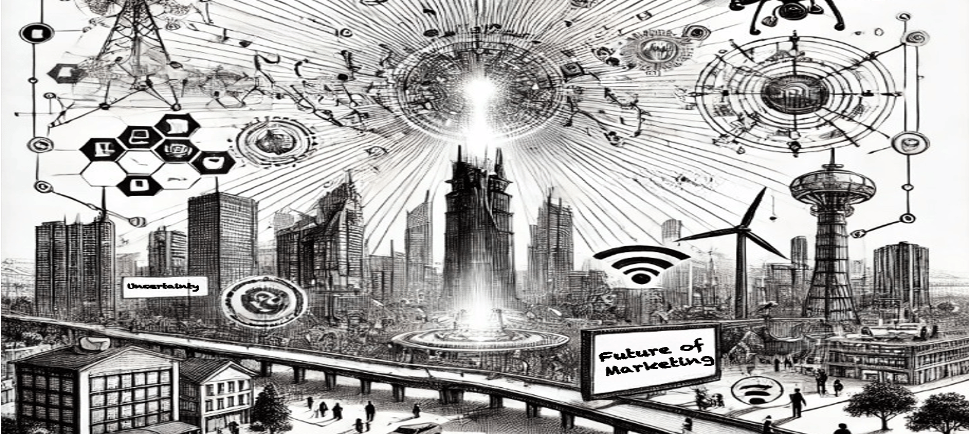Future of Marketing: Thriving in a New Era of Consumer Expectations and Economic Shifts
The blog post discusses the evolution of marketing in a digital age, emphasizing the importance of data-driven strategies and customer-centric approaches.
Eric. J. Siano
12/5/20243 min read


Future of Marketing: Thriving in a New Era of Consumer Expectations and Economic Shifts
The digital age has reshaped the marketing landscape, making it more complex yet more exciting. Marketing can no longer be a standalone function—it’s a strategic force that drives growth, aligns teams, and shapes business success. The silos between marketing, sales, customer experience, and technology need to dissolve, creating a new framework of holistic and dynamic business strategy.
Understanding the New Consumer
Today's consumers are:
Digitally Native: They rely heavily on digital channels for information, research, and purchasing decisions.
Experience-Driven: They seek personalized experiences that resonate with their values and lifestyle.
Ethical Consumers: They prioritize brands that align with their social and environmental beliefs.
Value-Conscious: They are more discerning and seek value for their money.
Navigating Economic Uncertainty
Economic fluctuations can significantly impact consumer behavior and purchasing power. Marketers must be agile and adaptable to navigate these challenges.
Key strategies include:
Value-Based Marketing: Emphasizing the value proposition and highlighting cost-saving benefits.
Customer Retention: Investing in customer retention strategies to maintain loyalty and reduce acquisition costs.
Diversifying Revenue Streams: Exploring new markets and diversifying product offerings to mitigate risk.
Marketing's Role as a Strategic Orchestrator
To effectively address these evolving dynamics, marketing must assume a strategic integrator role, bridging:
Product Development: Ensuring products align with market needs and consumer preferences.
Customer Insights: Leveraging data and analytics to understand consumer behavior and preferences.
Technology Implementation: Utilizing technology to enhance marketing effectiveness and customer experience.
Sales and Service Strategies: Collaborating with sales and service to drive revenue through leveraging the five growth factors: acquisition, retention, winbacks, expansions and margins.
Experience Design: Creating seamless and personalized customer journeys across all touchpoints.
C-Suite Integration: To ensure alignment with the overall business strategy, marketing teams must collaborate closely with C-suite colleagues. This integration is crucial for:
Strategic Decision Making: Providing data-driven insights to inform high-level business decisions.
Resource Allocation: Securing necessary resources to implement marketing initiatives.
Measuring Success: Aligning marketing outcomes with overall business outcomes.
Key Priorities for 2025 and Beyond
To thrive in this new era, marketers must prioritize the following:
Personalization at Scale
AI-Powered Personalization: Using AI to deliver highly tailored experiences at scale.
Dynamic Content: Creating content that adapts to individual preferences and behaviors.
Data and Insight Strategies
Data Privacy and Security: Ensuring compliance with data privacy regulations and protecting customer data.
Insight-Driven Decision Making: Leveraging data/insights to inform marketing strategies and measure performance.
AI-Driven Content and Automation
AI-Generated Content: Using AI to create high-quality content efficiently.
Marketing Automation: Automating repetitive tasks to increase efficiency and productivity.
Streamline processes: Automate routine tasks like email campaigns and social scheduling.
Sustainability and Social Responsibility
Sustainable Marketing Practices: Adopting eco-friendly and ethical marketing practices.
Social Impact Initiatives: Supporting social and environmental causes.
Creator Economy
Influencer Partnerships: Collaborating with influencers to reach target audiences.
User-Generated Content: Encouraging customers to create and share content.
Customer Retention
Loyalty Programs: Implementing loyalty programs to reward and retain customers.
Customer Experience Management: Prioritizing customer experience to build long-term relationships.
Short-Form Video and Interactive Content
Short-Form Video: Leveraging platforms like TikTok and Instagram Reels to reach younger audiences.
Interactive Content: Engaging audiences with quizzes, polls, and other interactive elements.
Web3 and Blockchain
Decentralized Marketing: Exploring decentralized marketing models and blockchain technology.
NFT Marketing: Utilizing NFTs for unique marketing campaigns and collectibles.
Hyperlocal Marketing
Geo-Targeted Campaigns: Delivering targeted marketing messages to specific geographic locations.
Local Partnerships: Collaborating with local businesses and influencers.
Agile Marketing and Testing
Rapid Iteration: Quickly testing and iterating on marketing campaigns.
A/B Testing: Experimenting with different marketing approaches to optimize results.
Strengthening Resilience Against Economic Uncertainty
Diversification: Expanding into new markets and product categories.
Cost Optimization: Identifying cost-saving opportunities.
Voice and Visual Search
Voice Search Optimization: Optimizing content for voice search queries.
Visual Search Marketing: Leveraging visual search to attract customers.
Ethical AI and Transparency
Transparent AI Practices: Disclosing the use of AI and its impact on decision-making.
Ethical AI Development: Ensuring AI is used responsibly and ethically.
Experience Over Possessions
Experiential Marketing: Creating memorable experiences that connect with consumers on an emotional level.
Subscription Models: Offering subscription-based services to provide ongoing value.
The Soul of Marketing: Human Connection
While technology and data play a vital role in modern marketing, it's important to remember that at its core, marketing is about human connection. Building strong relationships with customers and fostering brand loyalty requires empathy, creativity, and storytelling.
Key Considerations:
Credibility: Be genuine and authentic in your brand messaging.
Empathy: Understand your customers' needs and emotions.
Storytelling: Craft compelling narratives that resonate with your audience.
Final Strategic Imperative: Remain curious, empathetic, and relentlessly forward-thinking. By addressing what matters most to consumers—value, trust, and meaningful connection—your brand can build loyalty that transcends transactions.
Success lies in not just adapting to the future but shaping it.
